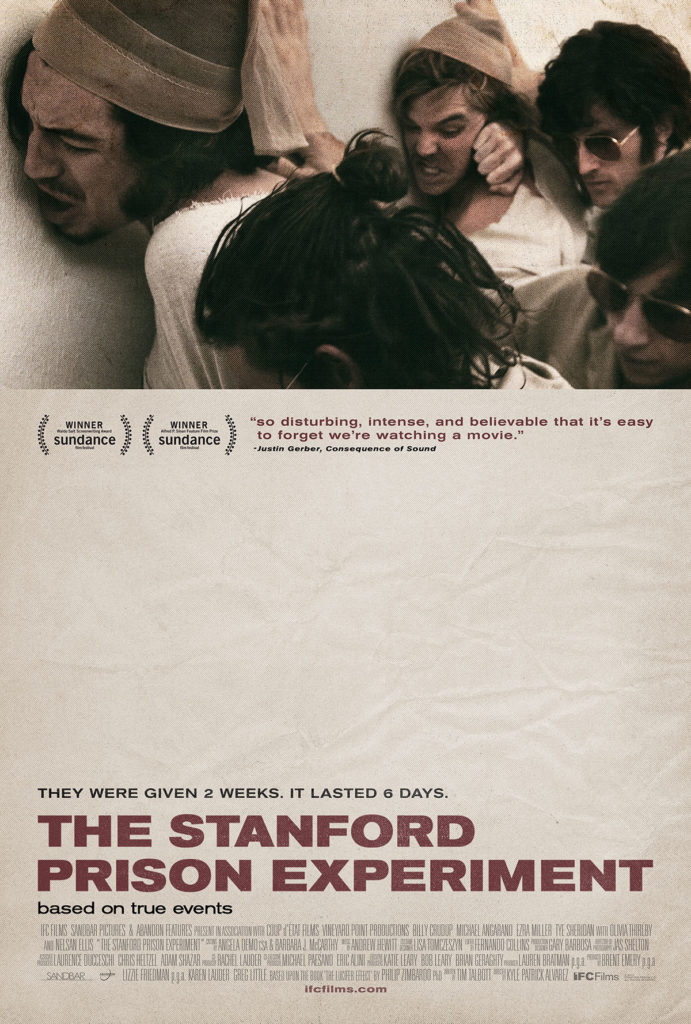A year after I added “The Stanford Prison Experiment” to my To-Watch list, I had the opportunity to see it. The tag line for the film is intriguing.
THEY WERE GIVEN 2 WEEKS. IT LASTED 6 DAYS.
The 2015 film is based on a psychological study conducted in August of 1971 by Dr. Philip Zimbardo, a Stanford University professor. Dr. Zimbardo recruited male volunteers who would be paid $15 a day for an experiment that was expected to last up to two weeks. After testing and questioning the applicants, a set of volunteers was selected. Volunteers were given conduct guidelines and contracts to sign. A coin toss decided which volunteers would be guards and which would be prisoners. Zimbardo and fellow researchers were to serve as warden of the prison. He and his research team transformed the basement of a campus building into The Stanford County Jail. Cameras and microphones were set up to provide the opportunity to observe the experiment.
At the start of the study the volunteers assigned to be guards arrived at the prison and were given uniforms which included mirrored sunglasses intended to limit social intimacy between guards and prisoners. As guards, they would work in shifts and be allowed time off. Volunteers assigned the role of prisoners were rounded up from their homes and taken to the jail in police cars. Upon arrival the inmates were told to strip, and after a delousing, given only a dress displaying their assigned number and a hosiery cap to be worn at all times. Unlike the guards, the prisoners were to be allowed no time off.
Within the first day, each side began to take its role more seriously. The guards set and enforced increasingly more strict rules and began to mete out severe punishments. The prisoners followed the rules and began to feel stripped of their own identities. Because there were no windows or clocks inside the prison, the prisoners seemed to lose track of time. Further, they began to feel as if they were really being confined against their will. Solitary confinement, visiting day, a consultation with a priest, and a parole hearing all contributed to feelings of disorientation, fatigue, and eventually, hopelessness on the part of the volunteers portraying prisoners.
Nearly everyone involved fell right into line, and the researchers failed to step in even as they objected to the escalating number of dehumanizing incidents they witnessed and recorded. A colleague of Zimbardo who dropped by raised questions about methodology of the experiment. A consultant, who had served a 17-year sentence, left after his role in a parole hearing simulation made him uncomfortable. Only after Christina Maslach, PhD was brought in to conduct interviews pointed out that the prisoners’ treatment she’d observed was disturbing, did Dr. Zimbardo call it off. The last few minutes of the film depict debriefing encounters between the volunteers after the experiment had ended. The volunteer who earned the nickname “John Wayne” because he had been the ringleader of sadistic behavior said he’d been surprised because no one ever told him what he was doing was unacceptable.
This was a tough movie to watch. I kept asking myself why the researchers did not step in and enforce the boundaries that had been set. It was a dramatization of actual events, but it seems to be a faithful recreation of what transpired. When bullying, gossip, hazing and other unpleasant social conduct occurs, too many people are reluctant to put their necks on the line for whatever reason. Unfortunately, I include myself in that group of people, though I am a work in progress. This was a reminder to be vigilant about my own behavior and to the rights of others.
Though it’s been ages since I’ve read it, this movie certainly brought to mind the rapid devolution of decent social behavior in Lord of The Flies by William Golding. In that book, a group of school boys stranded following a school trip, quickly turns on weaker classmates and becomes increasingly abusive. It is also reminiscent of a poem by Martin Niemöller called “First They Came”. In the poem the narrator laments the fact that because he did not speak up as he witnessed members of other groups suffer persecution, there was no one to protest when he was the target of persecution.
This film was an interesting study in power dynamics and gave me insight into human nature–not to mention a lot to think about.
Are you familiar with this study? If you’ve seen the film, I’d love to hear what you think of it!
For More Information:
- Background about the 2015 film “The Stanford Prison Experiment“
- The Stanford Prison Experiment website
- The Lucifer Effect: Understanding How Good People Turn Evil, a 2007 book by Philip Zimbardo
- “Quiet Rage: The Stanford Prison Experiment,” a 1992 documentary
- “The Stanford Prison Experiment,” a 2002 BBC documentary
- “Philip Zimbardo: The Psychology of Evil,” a 2008 TED Talk
Photo from IFC Films

